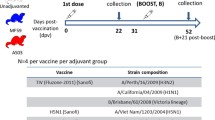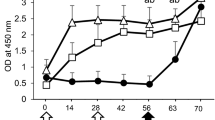Summary
The behaviour of three recombinant strains of influenza virus A/England/939/69 and A/PR/8, together with the parent A/England/939/69 strain, all of known virulence to man, were examined in ferrets. For the virulent A/England/939/69 strain, the peak temperature response and the time of peak virus excretion occurred 48 hours post-infection, and peak protein and secretory antibody responses occurred on days 7 and 9. In contrast, the peak temperatures and maximum virus excretions for the recombinant attenuated viruses, clones 7 and 6a, occurred on day 3 and 6, and the maximum protein and nasal antibody responses on days 9 and 11, respectively. Although the peak responses for these strains were distinct, the magnitudine of the symptoms was comparable. Similar studies with the over attenuated clone 64C virus showed a milder infection. In addition, the maximum temperature response and virus excretion occurred on day 5 post-infection, and the maximum nasal protein concentration was found on day 11 after virus infection. These differences between the strains were only apparent when animals were given an inoculum of 10 EID50; no differences were observed between the four strains when larger inocula were used. The results suggest that virus infection of ferrets was distinct for strains of differing human virulence, and that the ferret model may provide a test for virulence for man.
Similar content being viewed by others
References
Aymard-Henry, M., Coleman, M. T., Dowdle, W. R.: Influenza virus neuraminidase and neuraminidase inhibition test procedures. Bull. W.H.O.48, 199 (1973).
Beare, A. S., Hobson, D., Reed, S. E., Tyrrell, D. A. J.: A comparison of live and killed influenza virus vaccines. Lancetii, 418–420 (1968).
Beare, A. S., Bynoe, M. L., Tyrrell, D. A. J.: Investigation into the attenuation of influenza viruses by serial passage. Brit. med. J.4, 482 (1968).
Beare, A. S., Hall, T. S.: Recombinant influenza A viruses as live vaccines for man. Lancetii, 1271 (1971).
Beare, A. S., Craig, J. W., Schild, G. C.: Trials in man with live recombinants made from A/PR/8/34 (H0N1) and wild H3N2 influenza viruses. Lancet1975, 729.
Fazekas de St. Groth, S., Witchell, J., Lafferty, K. J.: An improved assay for neutralization antibodies against influenza viruses. J. Hyg. (Camb.)56, 415 (1958).
Hara, K., Beare, A. S., Tyrrell, D. A. J.: Growth and pathogenicity of influenza viruses in organ cultures of ciliated epithelium. Arch. ges. Virusforsch.44, 227 (1973).
Lowry, O. H., Rosebrough, N. J., Farr, A. L., Randall, R. J.: Protein measurement with the folin phenol reagent. J. biol. Chem.193, 265 (1951).
Maasaab, H. F., Kendall, A. P., Davenport, F. M.: Hybrid formation of influenza virus at 25° C. Fed. Proc.30, 413 (1971).
McCahon, D., Schild, G. C.: Segregation of antigenic biological characteristics during influenza virus recombination. J. gen. Virol.15, 73 (1972).
Michaels, R. H., Mahmud, M. I. A., Coup, A. J., Jennings, R., Potter, C. W.: Influenza virus infection in newborn rats: a possible marker of attenuation for man. (In press.)
Mostow, S. R., Tyrrell, D. A. J.: Detection of attenuation of recombinant influenza viruses “in vitro”. Lancetii, 116 (1972).
Mostow, S. R., Tyrrell, D. A. J.: The behaviour “in vitro” of attenuation of recombinant influenza viruses. Arch. ges. Virusforsch.43, 385 (1973).
Murphy, B. R., Chalhub, E. G., Nusinoff, S. R., Chanock, R. M.: Temperature-sensitive mutants of influenza virus. II. Attenuation ofts recombinants for man. J. inf. Dis.126, 170 (1972).
Potter, C. W., Oxford, J. S., Shore, S. L., McLaren, C., Stuart-Harris, C. H.: Immunity to influenza in ferrets I. Response to live and killed virus. Brit. J. exp. Pathol.53, 153 (1972).
Potter, C. W., McLaren, C., Jennings, R.: Assessment of resistance to influenza virus infection in animal models. Dev. biol. Stand.28, 307 (1975).
Prinzie, A., Delem, A., Huygelen, C.: Protective efficacy of a live attenuated, influenza virus vaccine (“Alice” strain). Postgrad. med. J.52, 395 (1976).
Toms, G. L., Bird, R. A., Kingsman, S. M., Sweet, C., Smith, H.: The behaviour in ferrets of two closely related clones of influenza virus of differing virulence for man. Brit. J. exp. Pathol.57, 37 (1976).
Author information
Authors and Affiliations
Additional information
With 3 Figures
Rights and permissions
About this article
Cite this article
Fenton, R.J., Jennings, R. & Potter, C.W. Differential response of ferrets to infection with virulent and avirulent influenza viruses: A possible marker of virus attenuation. Archives of Virology 55, 55–66 (1977). https://doi.org/10.1007/BF01314479
Received:
Accepted:
Issue Date:
DOI: https://doi.org/10.1007/BF01314479




